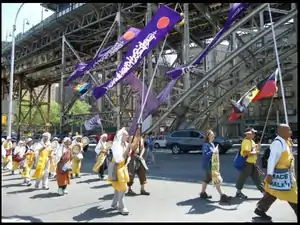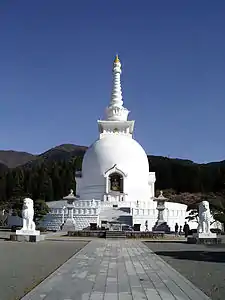Nipponzan-Myōhōji-Daisanga
Nipponzan-Myōhōji-Daisanga (日本山妙法寺大僧伽), often referred to as just Nipponzan Myohoji or the Japan Buddha Sangha, is a Japanese new religious movement and activist group founded in 1917 by Nichidatsu Fujii,[1] emerging from Nichiren Buddhism.[2] "Nipponzan Myōhōji is a small Nichiren Buddhist order of about 1500 persons, including both monastics and lay persons."[3][4] The community reveres the Lotus Sutra as the highest expression of the Buddhist message.
| Part of a series on |
| Buddhism |
|---|
 |
|
In addition, it is actively engaged worldwide in the peace movement.[5] It is the most pacifist group in Japan of seven religious movements surveyed by Robert Kisala.[6] The main practice of Nichiren Buddhism is to chant Namu Myōhō Renge Kyō. Nipponzan-Myōhōji monks, nuns and followers beat hand drums while chanting the Daimoku, and walk throughout the world promoting peace and non-violence. They try to explain the meaning of their ministry to all wishing to understand it.[7]
Peace pagodas and pilgrimages


The most recognizable achievement of Nipponzan-Myōhōji is peace pagodas (stupas), that have been erected in various locations around the world, the first of which was inaugurated in 1954 at Kumamoto in Japan. Since then cities such as London,[8] New Delhi, Vienna, Comiso (in Italy) and Tokyo have all received peace pagodas.
It has also undertaken numerous peace pilgrimages made by its followers. One of the most prominent of these was the 1994–1995 pilgrimage from Auschwitz to Hiroshima by way of Bosnia, Iraq, Cambodia and other countries then experiencing the effects of war. That pilgrimage was known as The Interfaith Pilgrimage for Peace and Life. A more recent walk was the 2010 Walk for a Nuclear Free Future, a walk across the United States in support of a nuclear-free future.
Many argue that the order shows a certain political stance with its active opposition to the nuclear industry in Japan and U.S involvement in Okinawa. This has led to a difference in views with fellow Nichiren sect Soka Gakkai, who are often viewed as more conservative.


References
- Dharmawalk, a site dedicated to the Nipponzan Myōhōji and its founder, Nichidatsu Fujii
- "buddhistinformation.com". BuddhistInformation.com. Archived from the original on 24 June 2006. Retrieved 16 June 2017.
- Kisala, Robert, "Nipponzan Myohoji". In: Clarke, Peter B. (2006). Encyclopedia of new religious movements, New York : Routledge. ISBN 0415267072, p. 463
- Stone, Jaqueline, I. (2003). "Nichiren's Activist Heirs: Soka Gakkai, Rissho Koseikai, Nipponzan Myohoji". In: Queen, Christopher, Prebish, Charles, Keown, Damien, editors (2003). Action Dharma: New Studies in Engaged Buddhism, New York, RoutledgeCurzon, p. 77. ISBN 0-7007-1594-0 PDF
- Christopher S. Queen. Engaged Buddhism in the West. Somerville, MA: Wisdom Publications, 2000, pp. 144. ISBN 9780861711598.
- Robert Kisala. Prophets of Peace. Honolulu: University of Hawai'i Press, 1999. pp. 56
- Ukrainian Traditionalist Club (March 9, 2013). "Традиционализм. Традиции Востока. Академическая наука" (in Russian). Archived from the original on 24 March 2017. Retrieved 31 March 2014.
the word was taken the most colorful of all the present speaker - a Buddhist monk of the Order Nipponzan Myōhōji Sergei Filonenko (Russian: слово взял самый колоритный из всех присутствующих докладчик – буддийский монах ордена Ниппондзан Меходзи Сергей Филоненко)
- "Thank you for visiting ProGalleries - PhotoBox". PhotoBoxGallery.com. Retrieved 16 June 2017.
- "The New England Peace Pagoda". The New England Peace Pagoda. Retrieved 16 June 2017.
External links
- United Nations Department of Public Information Non-Governmental Organization Entry for Nipponzan Myōhōji organization
- Peace Abbey awards Nipponzan-Myohoji the Courage of Conscience Award #71